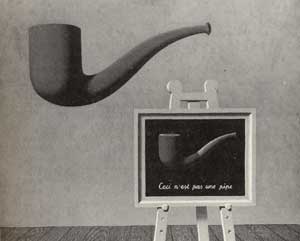 |
|
Introduction: Notes on Visual Rhetoric David Blakesley continued . . .
We have focused primarily on the image of the pipe, but what also can we make of the assertion, "This is not a pipe"? The word pipe also functions as a sign in this painting. Magritte uses the pronoun ceci ("this") to point to the image, but it might just as easily be understood to be referring to the word "pipe," or even to the assertion itself as a performative act. But, again, the letters p-i-p-e are not the same thing as that image of the pipe. Magritte is trickily suggesting also that just as images are not the same as the things they represent, words do not have that one-to-one correspondence either. The word pipe could, we might imagine, also refer to a piece of plumbing, a musical instrument, drug paraphernalia, a cask, or even "to speak in a shrill manner" (as in "Pipe down!"). Note also that he must use the negative, "not a pipe" to make the point. He hasn't said what it is, either, but instead simply asserted (in the most general sense) "I know not what this is, but it's not a pipe." Pushed to the limit, I think Magritte is demonstrably wrong because the assertion that "This is not a pipe" only has truth value to the extent that you accept that the word pipe signifies some referent unambiguously. In fact, the word pipe has quite a bit in common with a painting of a pipe, both being representations functioning as signs in an arbitrary symbolic system. And yet the negative also always already has some truth value (or cannot be proven wrong) because to say what a thing is not is to make no claim about what it positively is. In Roland Barthes's phrasing, "the photograph has something tautological about it: a pipe here is always and intractably a pipe. It is as if the Photograph always carries its referent with itself" (5). Self-referentiality can go on ad infinitum. Magritte's painting, Les deux mystères ("The Two Mysteries") shows the painting of the pipe on a painter's easel with a large pipe suspended in mid-air to its upper-left. 
Illustration 2. Les deux mystères (1966) by René Magritte. Is the "real" pipe the one we can touch? If I hold a pipe in my hand, is it really a pipe? To answer that question, we must make reference to a lexical category represented by the letters p-i-p-e, and while the uncomplicated response might be "Sure, it's a pipe," in the right context or with the right kind of pipe, it could also be a class marker, a sign of rampant drug use, or something else. When is a pipe a pipe? The visual and rhetorical turns in modern thought track down the implications of what at first seems to be just a witty observation. However, when you consider these implications deeply, you realize that if the relationship between the word and its referent is ambiguous and that it is more or less fixed by context (in the case of the Magritte painting in Illustration 1, the physical proximity of the image of the pipe to the word pipe), then there are enormous consequences for our understanding of truth, meaning, and reality. No longer is it possible to believe naively in the idea that our words or images can render a fixed reality even though trusting such a belief is necessary at every turn, step, or glance. Furthermore, we also realize that the words and images we use to represent the world and our experience are assertions of a perspective that say, essentially, "think of the world in these terms (rather than those)," or "see the world in these images (not those)." From this perspective, the act of naming in words and images becomes profoundly rhetorical. That is, any expression in words or images makes assertions that reflect the perspective and attitude of those who name, and (potentially) influences the interpretation of the hearer, the reader, or the spectator. When you consider as well that the process moves in both directions (seeing itself as the expression or assertion of power), you have the invitation to consider the visual and the textual as inextricably linked in the parallel acts of believing, interpreting, persuading, and identifying-each a rhetorical act in its own right worthy of a closer look, such as we hope you find in this issue of Enculturation. —David Blakesley and Collin Brooke 1 | 2 | 3 | 4 | Works Cited
|